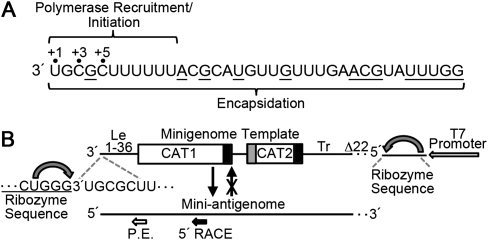FIGURE 1.
(A) Diagram showing the sequence of the RSV Le nucleotides 1–36, with the regions required for polymerase recruitment and initiation, and encapsidation indicated. Positions +1, +3, and +5, which were found to be used as initiation sites in this study, are marked. Nucleotides that are different from those in the TrC promoter are underlined. (B) Schematic diagram (not to scale) depicting the dicistronic minigenome template. The 3′ end of the minigenome consists of the first 36 nt of Le sequence, which directly abuts a CAT-specific sequence that has the RSV N-P gene junction inserted, resulting in two segments, CAT 1 (552 nt) and CAT 2 (190 nt). The 3′ terminus of the Le sequence is generated by a delta ribozyme (curved arrow), which creates a 2′,3′ cyclic phosphate group at the end of the template RNA, while the 5′ terminus of the minigenome is created by a hammerhead ribozyme. Note that CAT 1 lacks a transcription-specific gene start signal but possesses a gene end signal, as indicated by a black box. CAT 2 is separated from CAT 1 by a short intergenic region and is flanked by gene start (gray box) and gene end signals. The 5′ terminus of the minigenome consists of the RSV Tr, with a 22-nt deletion at the 5′ end, as indicated by a dotted line. This deletion removes the promoter from the mini-antigenome replication product such that it is unable to act as a template for new minigenomes, as depicted by the arrow with the cross. The positions on the replication product where reverse transcription primers for primer extension (P.E.) and 5′ rapid amplification of cDNA ends (5′-RACE) hybridize are shown.

